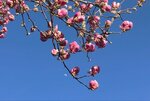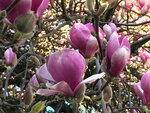

Aided by calm, blossom-friendly weather, we’re having a wonderful run of spring-flowering trees, and the procession just keeps on coming. It’s been fun to watch the news these past couple of weeks, as in both Washingtons – D. C. and the University of – live “cherry cams” tracked the bud-to-blossom happiness that brings out hordes of admirers. Our capitol campus was, of course, part of the action. So were lots of parks, yards, and local streets that brimmed with every species and cultivar of flowering cherry, in shades from white to put-on-your-shades pink.
Now, the visual feast is continuing as the magnolias – trees that recede into anonymity for the rest of the year – remind us that they are the real queens of spring. Their flowers are huge compared to cherry blossoms, with more varied and subtle colors. If you look closely at their buds and blossoms, you’ll see this is a flower like no other.
One reason may be that magnolias evolved nearly 100 million years ago – long before bees. Many are pollinated by beetles, though some are now fertilized by flies or bees. They are indigenous to multiple continents. And although most people think of magnolias as a Southern tree, there are obviously varieties that thrive here – including the smaller, shrubbier white star magnolia; the spectacular trees, sometimes called tulip trees, that are just now passing their peak of bloom; and the evergreen ones that bloom later and longer. The magnolias make the earlier flowering cherries seem modest and demure by comparison. You would think magnolias might mark the climax of spring flowering trees.
But wait. Here come the dogwoods. Count yourself lucky if you live near native dogwoods, which are just now starting to flower. (Yes, it’s really a bract, not a flower, but this is not a botany class.) The white-flowered native is inconspicuous except when it’s blooming, which it does in both spring and fall. When they’re not blooming, the casual oaf might regard them as just generic trees. This makes them vulnerable to chainsaws and to homeowners who don’t understand their irreplaceable value. (Like madronas, they are averse to fertilizers, pesticides, and other urban disturbances.)
Next, the classic front yard pink dogwoods will open, signaling the imminence of Mother’s Day. I wonder what percentage of these lovely small trees started out as saplings that were Mother’s Day presents. That’s a tradition that deserves revival.
Finally, the spring season of tree bloom will have a long, lingering finish with the flowering of all the fragrant fruit trees, both wild and cultivated. Bees will be busy.
This spring procession of flowering tree species may be the biggest array of floral glory, but it’s not the only one: we are also witnessing all the spring-blooming species of native flowers and shrubs; all the early blooming garden flowers; all the early rhododendrons and azaleas . . . we may need time off just to look, to marvel, and to drink in the joy of the earth’s celebration of itself.
The “real” Procession of the Species, on Saturday, April 27 at 4:30 PM in downtown Olympia, will give us a chance to celebrate all this together, and to see what art this magnificent spring has inspired.
Then we can get back to weeding and planting.
Jill Severn writes from her home in Olympia, where she grows vegetables, flowers, and a small flock of chickens. She loves conversation among gardeners. Start one by emailing her at jill@theJOLTnews.com
3 comments on this item Please log in to comment by clicking here
GinnyAnn
Don't forget the joy of heavenly scented lilacs in late spring! They were brought by the first pioneer women to remind them of their old homes, and now they remind me of my childhood home. Lilacs are nostalgic.
Saturday, April 6 Report this
KarenLJ
And speaking of magnolias, don't forget the Japanese bigleaf magnolia on the grounds of the Schmidt House (330 Schmidt Pl SW, Tumwater). In mid to late May, this great tree will bear heavy cream-colored flowers as large as a dinner plate and with the most magnificent fragrance. Our magnolia was recently added to the City of Tumwater Heritage Tree list.
Sunday, April 7 Report this
Terrilovesanimals
I would love a dogwood sapling form Mother's Day! Got an azalea last year. Hope it made it through the winter! Wondering why my forsythia only had a few flowers this year. Very odd.
Tuesday, April 9 Report this